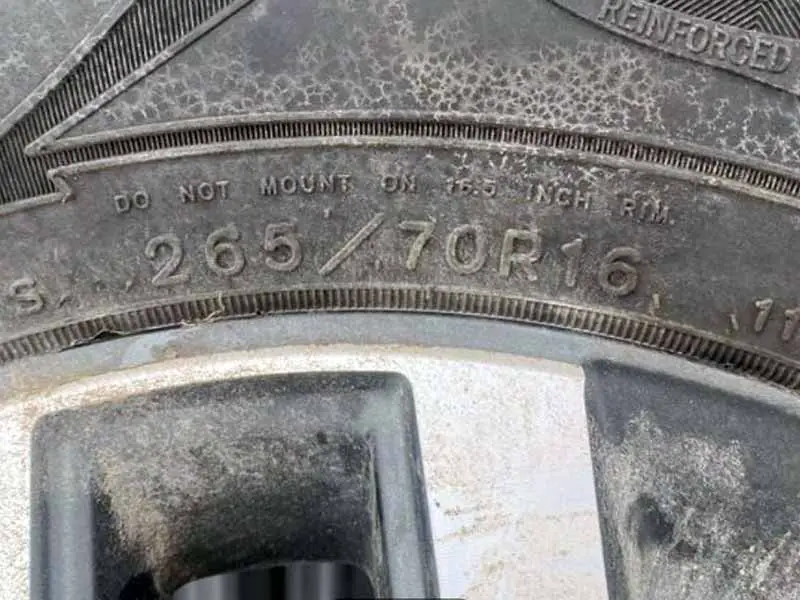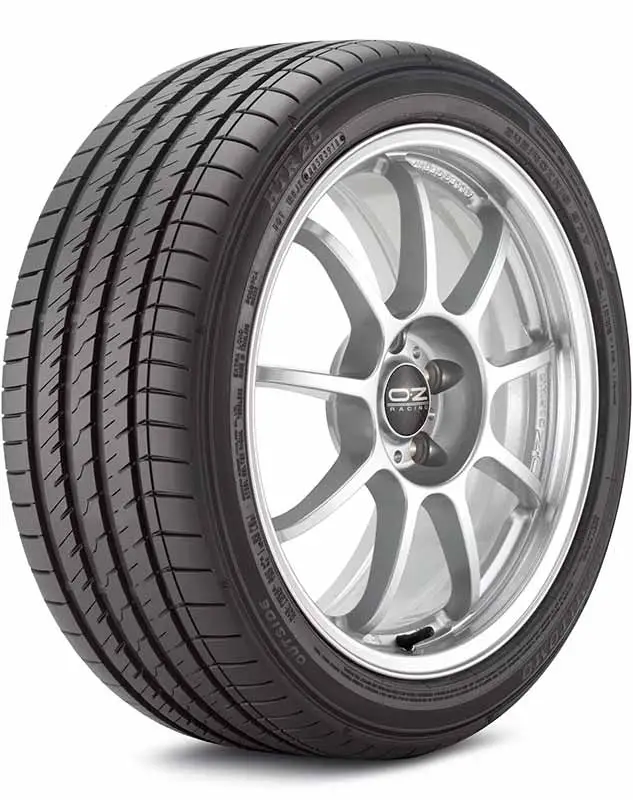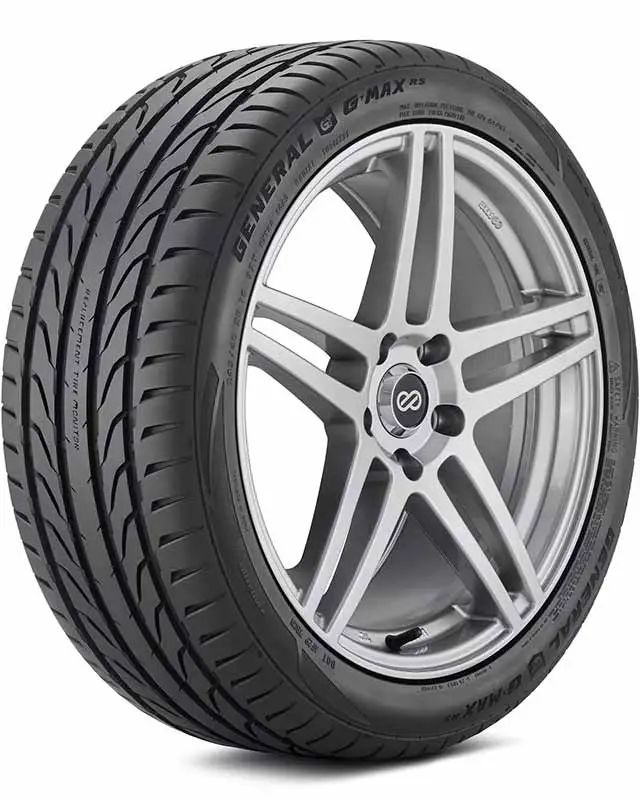Have you ever wondered what those mysterious numbers on your tires mean and how they affect your vehicle’s performance? Unlock the secret behind those numbers and learn how to choose the perfect tires for your ride with our comprehensive guide.
What Do The 3 Numbers Mean On Tire Size?
The 3 main numbers on a tire represent its 3 main size measurements: tire width, aspect ratio, and wheel diameter. Understanding these numbers can help you choose the right tires for your vehicle, ensuring safety, performance, and comfort.
In this article, we’ll delve into the meaning of each number on your tire size, explain how to read them on your vehicle’s tires, and discuss why selecting the correct tire size is crucial for optimal driving experience.
Let’s take a closer look.
The First Number: Tire Width
Tire width refers to the distance from one side of the tire’s tread to the other side, measured in millimeters (mm). This number gives you an idea of how wide the tire is, which is crucial when it comes to how your vehicle handles on the road.
Measuring Tire Width
Section width is an important tire measurement that refers to the distance between the tire’s inner sidewall and its outer sidewall at the widest point, excluding any protective ribs, decorations, or raised letters. Accurate measurement of section width helps ensure proper tire performance, safety, and wear. Here’s a revised step-by-step guide on how to measure the section width of a tire:
- Identify the widest point: Visually inspect the tire to find its widest point, where the inner sidewall and outer sidewall are farthest apart. Keep in mind that you’ll need to exclude any protective ribs, decorations, or raised letters from your measurement.
- Align the straight edge or ruler: Place a straight edge or ruler on the tire, perpendicular to the tire’s axis, so it’s touching both the inner and outer sidewalls at their widest point. Ensure the straight edge is level and not tilted.
- Measure the distance between the sidewalls: Using a tape measure or caliper, measure the distance between the inner and outer sidewalls where the straight edge or ruler is touching. This measurement is the section width of the tire.
Why Tire Width Matters
Now that you know what tire width is and how it’s measured, let’s talk about why it’s so important:
- Performance: Wider tires tend to provide better grip on the road, which can improve handling and braking. This can be especially helpful when driving in wet or slippery conditions.
- Safety: The right tire width ensures that your vehicle has the proper contact with the road, keeping you safe while driving. Using tires that are too narrow or too wide for your vehicle can lead to less stability and increased risk of accidents.
- Fuel Efficiency: Believe it or not, tire width can impact your gas mileage! Wider tires can create more rolling resistance, which can lower your fuel efficiency. However, it’s important to balance this with the need for proper traction and handling.
Common Tire Widths for Passenger Cars and Trucks
Now that you understand the importance of tire width, let’s take a look at some common widths for passenger cars and trucks:
- Passenger Cars: Typical tire widths for passenger cars range from 175 to 235 millimeters. Smaller cars may have tire widths around 175-195 millimeters, while larger sedans and minivans may use tires between 205 and 235 millimeters wide.
- Trucks: For pickup trucks and SUVs, you might see tire widths ranging from 235 to 315 millimeters. Keep in mind that off-road or performance-oriented trucks may use even wider tires for added traction and stability.
The Second Number: Aspect Ratio
The aspect ratio refers to the height of the tire’s sidewall compared to its width, expressed as a percentage. In simpler terms, it tells you how tall the tire is in relation to its width. This number can have a significant impact on your vehicle’s ride comfort, handling, and even appearance.
Calculating Aspect Ratio
To find the aspect ratio, look for the two-digit number after the slash in the tire size code printed on the tire’s sidewall. For example, if the code reads “205/55R16,” the aspect ratio is 55.
To calculate the actual height of the sidewall, multiply the tire width (in millimeters) by the aspect ratio (as a percentage). For our example, the sidewall height would be 205 mm x 0.55 = 112.75 mm.
Effects of Different Aspect Ratios
Aspect ratios can vary, and each comes with its own set of benefits and trade-offs:
- Low Aspect Ratio (40-50): Tires with a low aspect ratio, also known as low-profile tires, have shorter sidewalls. This can result in improved handling and a sportier look, but it might also make the ride feel stiffer and less comfortable.
- Medium Aspect Ratio (55-65): These tires strike a balance between handling and ride comfort. They’re commonly found on passenger cars, minivans, and small SUVs.
- High Aspect Ratio (70-80): Tires with a high aspect ratio have taller sidewalls, which can provide a smoother, more comfortable ride. However, they may not handle as well as tires with a lower aspect ratio.
Common Aspect Ratios for Different Vehicles
Here’s a quick look at some typical aspect ratios you might find on various types of vehicles:
- Compact Cars: 55-65
- Sedans and Minivans: 60-70
- SUVs and Crossover Vehicles: 50-65
- Light Trucks and Pickups: 65-75
The Third Number: Wheel Diameter
Wheel diameter refers to the size of the wheel on which the tire is mounted, measured in inches. This number is crucial because it ensures that the tire you choose will fit properly on your vehicle’s wheels, providing optimal performance and safety.
Measuring Wheel Diameter
To find the wheel diameter, look for the two-digit number after the letter “R” in the tire size code printed on the tire’s sidewall. For example, if the code reads “205/55R16,” the wheel diameter is 16 inches.
Importance of Matching Wheel Diameter with the Right Tire Size
It’s essential to choose a tire with the correct wheel diameter for your vehicle. Here’s why:
- Safety: A tire that doesn’t fit the wheel properly can cause issues with braking, handling, and overall stability. This can put you and your passengers at risk.
- Performance: A mismatched tire and wheel combination can negatively impact your vehicle’s performance, including acceleration, cornering, and fuel efficiency.
- Wear and Tear: Using the wrong tire size for your wheel can cause uneven wear on both the tire and wheel, which can shorten their lifespan and lead to costly repairs.
Common Wheel Diameters for Passenger Cars and Trucks
Let’s take a look at some typical wheel diameters you might find on passenger cars and trucks:
- Passenger Cars: You’ll often see wheel diameters between 14 and 18 inches on passenger cars, with compact cars typically having smaller diameters (14-16 inches) and larger sedans and minivans using bigger wheels (17-18 inches).
- Trucks: For pickup trucks and SUVs, wheel diameters usually range from 16 to 22 inches. Off-road or performance-oriented trucks may have even larger wheels for added stability and traction.
Other Tire Size Numbers on the Sidewall
Apart from the primary tire size numbers (tire width, aspect ratio, and wheel diameter), there are additional codes and numbers found on a tire’s sidewall. These numbers provide valuable information about the tire’s construction, load capacity, and speed rating. Let’s explore these additional tire size numbers and their purpose.
Load Index
The load index is a numerical code that indicates the maximum load-carrying capacity of a tire. It’s important to choose a tire with an appropriate load index for your vehicle to ensure safety and prevent tire damage.
To find the load index, look for a two- or three-digit number following the tire size code, usually right before the speed rating. For example, in “205/55R16 91V,” the load index is 91.
You can refer to a load index chart to find the corresponding weight capacity in pounds or kilograms. In our example, a load index of 91 translates to a maximum load of 1,356 lbs (615 kg) per tire.
Speed Rating
The speed rating is a letter code that indicates the maximum speed at which a tire can safely carry a load corresponding to its load index. It’s crucial to choose a tire with a suitable speed rating for your vehicle and driving habits to ensure safety and performance.
To find the speed rating, look for a single letter following the load index on the tire’s sidewall. In the example “205/55R16 91V,” the speed rating is “V.”
You can consult a speed rating chart to determine the maximum speed for each letter code. In our example, a “V” speed rating means the tire can safely handle speeds up to 149 mph (240 km/h).
Tire Construction
The tire construction code is usually a single letter found within the tire size code. This letter represents the type of construction used in the tire. Most passenger vehicles use radial construction, which is represented by the letter “R” in the tire size code, such as “205/55R16.”
Other types of tire construction include:
- “B” for bias belt (diagonal construction with belts)
- “D” for diagonal (cross-ply construction)
It’s essential to choose a tire with the appropriate construction for your vehicle to ensure optimal performance, handling, and safety.
Additional Codes
Some tires may have additional markings or codes that provide information about the tire’s intended use, special features, or certifications. For example:
- “M+S” or “M/S” indicates that the tire is designed for mud and snow conditions.
- “XL” or “RF” means the tire has a higher load capacity due to reinforced construction (Extra Load or Reinforced).
Understanding UTQG Numbers on a Tire Sidewall
The Uniform Tire Quality Grading (UTQG) system is a set of ratings found on a tire’s sidewall that provides standardized information about a tire’s treadwear, traction, and temperature resistance. Developed by the United States Department of Transportation (DOT), UTQG helps consumers compare tire performance and make informed decisions when purchasing tires. Let’s explore each component of the UTQG rating system.
Treadwear
The treadwear grade is a three-digit number that indicates a tire’s relative wear rate compared to a reference tire tested under controlled conditions. A higher number suggests better treadwear performance and longer-lasting tires.
For example, a tire with a treadwear rating of 300 should last approximately twice as long as a tire with a rating of 150, given similar driving conditions and proper tire maintenance.
Keep in mind that the treadwear grade is a relative measure and not a guarantee of the exact mileage a tire will deliver. Factors such as driving habits, road conditions, and tire maintenance can influence actual tire wear.
Traction
The traction grade is a letter rating (AA, A, B, or C) that represents a tire’s ability to stop on wet surfaces under controlled conditions. This rating does not reflect cornering or dry braking performance.
The traction grades are as follows:
- AA: Highest traction performance
- A: Good traction performance
- B: Average traction performance
- C: Lowest traction performance permitted by law
A higher traction grade indicates better wet braking performance, which can contribute to overall driving safety.
Temperature
The temperature grade is a letter rating (A, B, or C) that reflects a tire’s resistance to heat generation and its ability to dissipate heat when tested under controlled conditions. Sustained high temperatures can cause tire failure, so this rating is crucial for safety.
The temperature grades are as follows:
- A: Highest temperature resistance
- B: Intermediate temperature resistance
- C: Minimal temperature resistance required by law
A higher temperature grade indicates a tire’s better ability to withstand and dissipate heat, which can contribute to longer tire life and reduced risk of tire failure.
Locating UTQG Ratings on the Sidewall
To find the UTQG ratings on a tire’s sidewall, look for a combination of letters and numbers that follow the tire size and other markings. For example, you may see something like “Treadwear 500 Traction AA Temperature A.”
It’s important to remember that UTQG ratings are useful for comparing tires within the same brand but may not be as accurate when comparing different brands. Always consult your vehicle’s owner’s manual, read consumer reviews, and consult with a tire professional to determine the best tire for your specific make, model, and driving needs.
Resources
Below are some links you may find helpful when learning about tires
- What do the numbers on my tires mean? – Firestone
- Tire size explained: What the numbers mean – Les Schwab
Final Thoughts
Cracking the code on your tire’s sidewall numbers might have felt like a mystery before, but now you have the keys to unlock the hidden world of tire specifications. The journey we took together, deciphering tire width, aspect ratio, wheel diameter, and other essential numbers, has empowered you to make informed decisions when purchasing tires for your vehicle.
The key takeaway from this article is that understanding the numbers on a tire’s sidewall is crucial for selecting the right tires that ensure safety, performance, and comfort. As Harvey S. Firestone, the founder of Firestone Tire and Rubber Company, once said, “The tire is the one component of a car that most influences how it will perform.” With your newfound knowledge, you can now confidently choose the tires that best suit your vehicle, driving conditions, and preferences, ensuring a superior driving experience.
Good luck and happy motoring.




